The Tides of Commerce
 First traveled by European explorers in 1791, the swift, navigable channel between Fidalgo and Guemes islands has long been the heart of the Anacortes working waterfront.
First traveled by European explorers in 1791, the swift, navigable channel between Fidalgo and Guemes islands has long been the heart of the Anacortes working waterfront.
 First traveled by European explorers in 1791, the swift, navigable channel between Fidalgo and Guemes islands has long been the heart of the Anacortes working waterfront.
First traveled by European explorers in 1791, the swift, navigable channel between Fidalgo and Guemes islands has long been the heart of the Anacortes working waterfront.
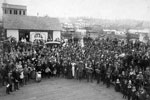 Since its days as an insular port city, Anacortes has loved a party. When there were no roads to connect early settlers, they convened by boat for balls and midnight suppers. Holidays have long filled the streets of the historic downtown.
Since its days as an insular port city, Anacortes has loved a party. When there were no roads to connect early settlers, they convened by boat for balls and midnight suppers. Holidays have long filled the streets of the historic downtown.
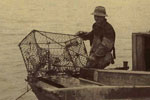 Dungeness crab, found in commercial quantities from Alaska to central California, is one of the most popular items on West Coast dinner tables. Anacortes traces its local crabbing traditions to Coast Salish subsistence harvesting.
Dungeness crab, found in commercial quantities from Alaska to central California, is one of the most popular items on West Coast dinner tables. Anacortes traces its local crabbing traditions to Coast Salish subsistence harvesting.
 For both work and play, the bays, beaches, and surrounding islands of the Salish Sea are integral to life on Fidalgo Island. Early settlers made their own fun, canoeing and rowing on lakes and bays, swimming in brisk ocean waters, and boating to nearby islands.
For both work and play, the bays, beaches, and surrounding islands of the Salish Sea are integral to life on Fidalgo Island. Early settlers made their own fun, canoeing and rowing on lakes and bays, swimming in brisk ocean waters, and boating to nearby islands.
 When Coast Salish tribes made their summer camps along local shores, the land transitioned naturally to the sea—forage fish laid eggs on shady pebble beaches; shellfish burrowed in eelgrass-covered mud flats; wetlands buffered wave action against the shore; and sloughing bluffs nourished nearby beaches.
When Coast Salish tribes made their summer camps along local shores, the land transitioned naturally to the sea—forage fish laid eggs on shady pebble beaches; shellfish burrowed in eelgrass-covered mud flats; wetlands buffered wave action against the shore; and sloughing bluffs nourished nearby beaches.
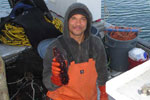 For almost a century, commercial fishing was a mainstay of the Anacortes economy. In the 1950s, the Puget Sound fishing fleet packed the marina stem to stern, enjoying the city's amenities and its convenient access to island and Alaskan waters.
For almost a century, commercial fishing was a mainstay of the Anacortes economy. In the 1950s, the Puget Sound fishing fleet packed the marina stem to stern, enjoying the city's amenities and its convenient access to island and Alaskan waters.
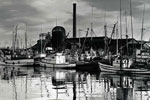 Harvesting local salmon and shellfish sustained native Coast Salish inhabitants for centuries. They traded these resources to early Anacortes settlers who were more interested in farming than fishing.
Harvesting local salmon and shellfish sustained native Coast Salish inhabitants for centuries. They traded these resources to early Anacortes settlers who were more interested in farming than fishing.
 The prominent rocky headland across the marina is perhaps the most notable—and enduring—feature of Fidalgo Bay, claiming a special place in local geologic and cultural history.
The prominent rocky headland across the marina is perhaps the most notable—and enduring—feature of Fidalgo Bay, claiming a special place in local geologic and cultural history.
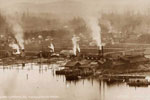 Abundant supplies of local timber gave rise to Anacortes' first industry—wood processing. By the early 1900s, 13 plants lined "Mill Row" along Fidalgo Bay's western shore. Spurred by the Oregon Land Donation Act of 1850, pioneer settlers moved west.
Abundant supplies of local timber gave rise to Anacortes' first industry—wood processing. By the early 1900s, 13 plants lined "Mill Row" along Fidalgo Bay's western shore. Spurred by the Oregon Land Donation Act of 1850, pioneer settlers moved west.
 Deep, navigable waters and a protected bay uniquely positioned Anacortes settlers to blend their determination, resources, and skills, setting in motion generations of marine innovation.
Deep, navigable waters and a protected bay uniquely positioned Anacortes settlers to blend their determination, resources, and skills, setting in motion generations of marine innovation.
 This was Anacortes Veneer—one of the foremost plywood mills in the nation. The whine of its lathes and pungent scent of glue marked the grand finale of lumber processing in Anacortes.
This was Anacortes Veneer—one of the foremost plywood mills in the nation. The whine of its lathes and pungent scent of glue marked the grand finale of lumber processing in Anacortes.
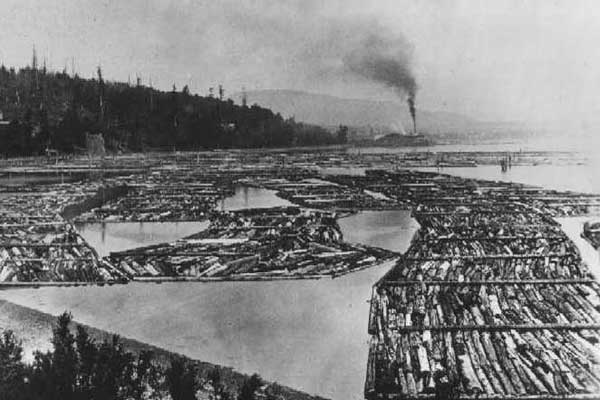 A little over a century ago, old-growth forests of massive firs and cedars covered much of the Pacific Northwest. Skagit Valley pioneers discovered a vast expanse of densely growing timber.
A little over a century ago, old-growth forests of massive firs and cedars covered much of the Pacific Northwest. Skagit Valley pioneers discovered a vast expanse of densely growing timber.
 Urged by the federal government to venture west in the mid-1800s, Northwest pioneers settled on the natural prairies around Puget Sound. In contrast to the region’s heavily forested interiors, these ready-made farmlands adjacent to marine waterways offered an appealing place to set down roots.
Urged by the federal government to venture west in the mid-1800s, Northwest pioneers settled on the natural prairies around Puget Sound. In contrast to the region’s heavily forested interiors, these ready-made farmlands adjacent to marine waterways offered an appealing place to set down roots.
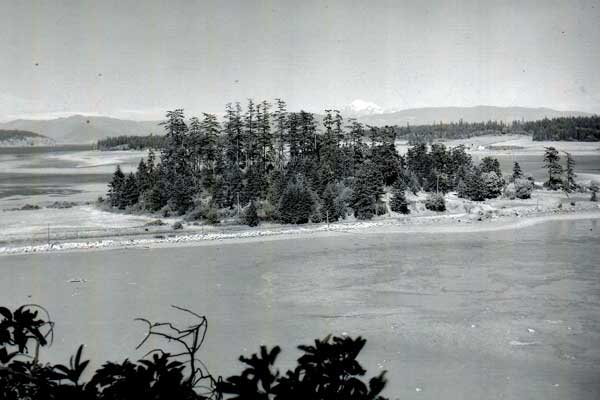 Weaverling Spit is a 47-acre, thumb-like projection into the middle of Fidalgo Bay. Over time, the spit hosted Coast Salish foraging grounds, pioneer homesteads, a gold mine, community picnics, and a boisterous dance hall.
Weaverling Spit is a 47-acre, thumb-like projection into the middle of Fidalgo Bay. Over time, the spit hosted Coast Salish foraging grounds, pioneer homesteads, a gold mine, community picnics, and a boisterous dance hall.
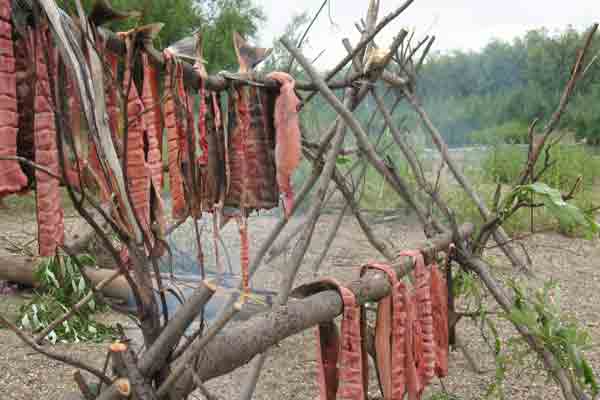 The shoreline of the Salish Sea is blessed with an abundance of natural riches. A nursery of broad tidal flats and marshes is flushed by nutrientrich salty and fresh waters, bordered by fertile uplands, and draped in a gentle climate.
The shoreline of the Salish Sea is blessed with an abundance of natural riches. A nursery of broad tidal flats and marshes is flushed by nutrientrich salty and fresh waters, bordered by fertile uplands, and draped in a gentle climate.
Information on this Trail Tales website was prepared under funding from the Washington State Department of Ecology’s Public Participation Grant Program. While the information was reviewed for grant consistency and accuracy of project references, this does not necessarily constitute endorsement by the Department.
Learn more about Ecology’s Anacortes Baywide Cleanup
Photo credits: Anacortes History Museum, Washington state Dept. of Ecology, Samish Indian Nation and others, as noted. Illustrations by Linda Feltner.
Copyright 2010-2021 by Friends of Skagit Beaches, a 501 (c)(3) tax-exempt non-profit organization.
Federal Tax ID 26-3040713. Donations may be tax deductible. | Guidestar Report | Contact Us